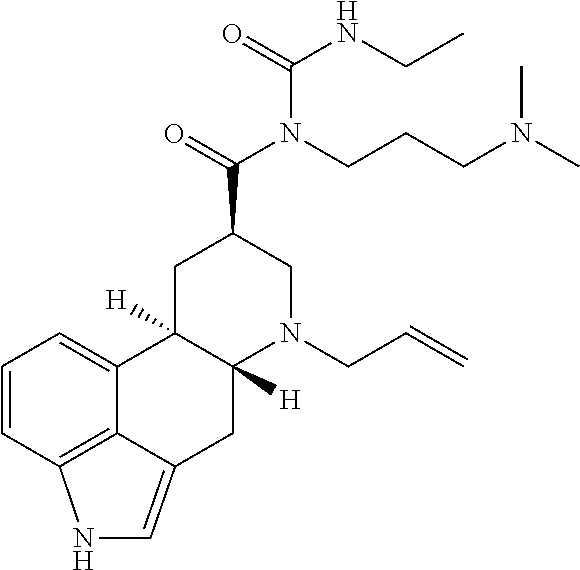Use of agonists of type-2 dopaminergic receptors in treatment of conditions caused by elevated vascular endothelial growth factor levels
a technology of vascular endothelial growth factor and agonists, which is applied in the direction of drug compositions, medical preparations, sense disorders, etc., can solve the problems of amd increase, retinal edema, and proliferation of pathological blood vessels
- Summary
- Abstract
- Description
- Claims
- Application Information
AI Technical Summary
Benefits of technology
Problems solved by technology
Method used
Image
Examples
example 1
[0025]The Effects of Administration of Cabergoline on Permeability of Blood-Retinal Barrier and on Retinal Thickness in an Experimental Model for Diabetic Retinopathy
[0026]The research was conducted on an experimental model of Wistar strain rats. In order to cause diabetes, the rats were injected intraperitoneally with streptozocin at a dose of 60 mg / kg b.w. After 30 days since administration of streptozocin blood glucose level was checked and only rats with the blood glucose levels of over 250 mg % were qualified for the experiment.
[0027]In the course of the experiment, the following parameters were assessed: permeability of blood-retinal barrier using the dextran method (BRB) and the thickness of the retina using optical coherence tomography (OCT).
[0028]In the experiment, 4 experimental groups were compared: healthy animals without cabergoline administration, healthy animals with cabergoline administration (14 days of use), animals with diabetes without cabergoline, animals with d...
example 2
[0029]The Effects of Administration of Cabergoline on Permeability of Blood-Retinal Barrier and Retinal Thickness in an Experimental Model for Central Retinal Vein Occlusion.
[0030]The research was conducted on an experimental model of Wistar strain rats. Central retinal vein occlusion was performed using a 532 nm laser.
[0031]In the course of the experiment, the following parameters were assessed: permeability of blood-retinal barrier using the dextran method (BRB) and the thickness of the retina using optical coherence tomography (OCT).
[0032]In the experiment, 4 experimental groups were compared: healthy animals without cabergoline administration, healthy animals with cabergoline administration (14 days of use), animals with central retinal vein occlusion without cabergoline, animals with central retinal vein occlusion with cabergoline (14 days of use). Cabergoline was administered to the animals in oral form at a dose of 0.05 mg / kg b.w. over 14 days.
Experimental group / ParameterBRB ...
example 3
[0033]The Effects of Administration of Cabergoline on Permeability of Blood-Retinal Barrier and Retinal Thickness in an Experimental Model for Choroidal Neovascularization (CNV).
[0034]The research was conducted on an experimental model of Wistar strain rats. Choroidal neovascularization (CNV) was performed by photocoagulation of the retina using a 532 nm laser.
[0035]In the course of the experiment, the following parameters were assessed: permeability of blood-retinal barrier using the dextran method (BRB) and the thickness of the retina using optical coherence tomography (OCT).
[0036]In the experiment, 4 experimental groups were compared: healthy animals without cabergoline administration, healthy animals with cabergoline administration (14 days of use), animals with CNV without cabergoline, animals with CNV with cabergoline (14 days of use). Cabergoline was administered to the animals in oral form at a dose of 0.05 mg / kg b.w. over 14 days.
Experimental group / ParameterBRB (μl / g / min)OC...
PUM
| Property | Measurement | Unit |
|---|---|---|
| Length | aaaaa | aaaaa |
| Length | aaaaa | aaaaa |
| Length | aaaaa | aaaaa |
Abstract
Description
Claims
Application Information
 Login to View More
Login to View More - R&D Engineer
- R&D Manager
- IP Professional
- Industry Leading Data Capabilities
- Powerful AI technology
- Patent DNA Extraction
Browse by: Latest US Patents, China's latest patents, Technical Efficacy Thesaurus, Application Domain, Technology Topic, Popular Technical Reports.
© 2024 PatSnap. All rights reserved.Legal|Privacy policy|Modern Slavery Act Transparency Statement|Sitemap|About US| Contact US: help@patsnap.com








